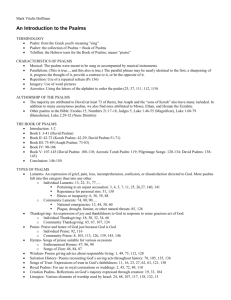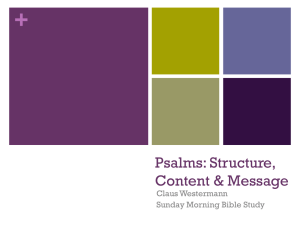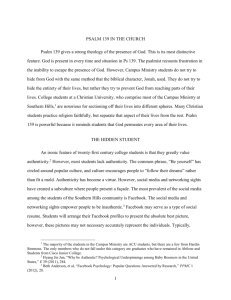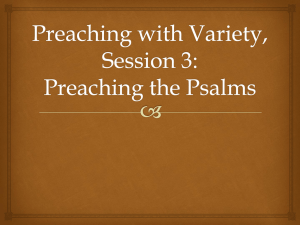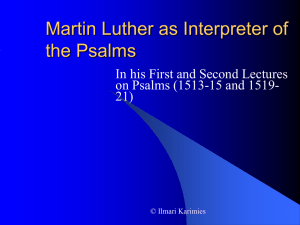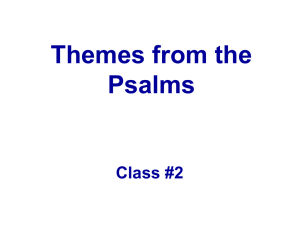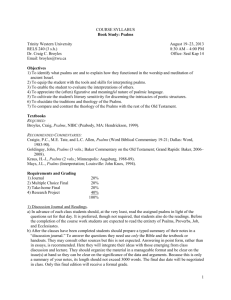Lesson-10 - Bald Eagle Baptist Church
advertisement
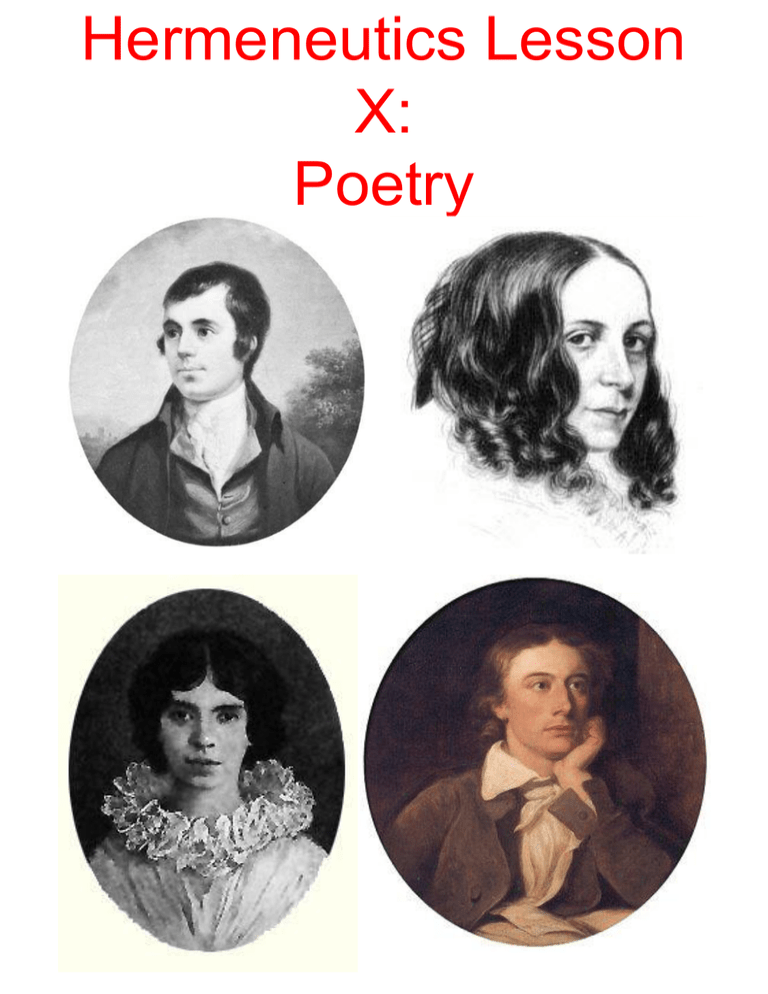
Hermeneutics Lesson X: Poetry A. Poetry distinguished from Prose. • In modern translations, poetry is usually indicated by the formatting of the text. • It’s also written using commissive language as opposed to referential language. • So the biblical poets are no different than modern poets – painting word pictures that appeal to the heart. B) Specific Forms of Poetry Unlike much of English poetry which is marked by rhyme and rhythm, Hebrew poetry is characterized primarily by parallelism. At times Hebrew poetry does contain rhyme and rhythm, but it is lost in translation. However, the parallelism will not be lost. 1. Synonymous Parallelism In synonymous parallelism, the second line in a stanza restates the first line using different vocabulary. As an example, note Psalm 18:4-5. The cords of death / encompassed me And the torrents of ungodliness / terrified me. The cords of Sheol / surrounded me The snares of death / confronted me. Notice how in each stanza there is a virtually precise AB/ab pattern. Sometimes the synonymous parallelism is in the form of a chiasm, as in Psalm 95:5. The sea is His/for it was He who made it. And His hands formed/ the dry land. Here the pattern is AB/ba. Sometimes the parallelism is incomplete. Note Lamentations 3:10. He is to me /like a bear / lying in wait like a lion / in secret places. The pattern is thus ABC/bc The parallelism is at times developed beyond one or two lines or phrases, such as with Psalm 1:1. Maybe we can call this EXTENDED PARALLELISM. How blessed is the man/who does not walk /in the counsel of the wicked nor stand / in the path of sinners nor sit / in the seat of scoffers This pattern is ABC/bc/b’c’ 2. Antithetical Parallelism • Here the second line contrasts with the first line. • A wise son / makes a father glad • But a foolish son / is a grief to his mother. • In antithetical parallelism, one can also find examples of chiasm, incomplete parallelism, and extended parallelism. • • Prov. 10:4 = chiasm • Prov. 23:31 = incomplete • Prov. 31:2 = extended (and also incomplete) 3. “Step” or “Climactic” Parallelism • In this, the second phrase takes the first to a higher plane, e.g . Matthew 10:40 b) And he who receives me receives Him who sent me a) He who receives you receives me, One could argue however, this is merely incomplete, synonymous parallelism. Synthetic Parallelism • This occurs when the second line does not repeat the first, but develops it. “But his delight is in the law of the Lord,/ And in his Law doth he meditate day and night. And he shall be like a tree planted by the rivers of water/ That brings forth its fruit in its season But notice, the first two lines are just incomplete synonymous parallelism in chiasm. • “But his delight • And in His Law is in the law of the LORD doth he meditate/ day and night 5. Acrostics Here, the verses follow an alphabetical pattern. A perfect example of this is Psalm 119. Made up of 176 verses, it is divided into 22 sections of 8 verses each. Every verse in each section begins with the same Hebrew letter in alphabetical order. Thus the first 8 verses all start with “aleph,” the second 8 verses all begin with “beth,” all the way to the end (“tav”). C) Psalms 1. Introduction a) they are poetry, and are written in commissive language. b) Despite being poetry, they still express objective truth. c) Since the historical/personal experiences of the Psalmist are different than ours, and since he expresses himself in culturally conditioned language, we must be vigilant in search of implications and significance to make application for our life and condition. d) Though all of the Bible is given by God to us, the Psalms are also man’s expression of faith, hope, pain, joy, and sorrow back to God. e) Psalms are a great aid to worship, and were used by the Jews as such. They are grett means by which we too can express ourselves to God in worship. f) The Psalms are usually identified with King David, they were written by a variety of individuals over a long period of time. Eventually the Psalms were compiled into 5 “books:” Pss. 1-41; 42-72; 73-89; 90-106; 107-150. 2. Types of Psalms a) Lament Psalms There are approximately 48 lament Psalms, making it the largest category of Psalms. individual: e.g. 3, 4, 5, 6, 7, 17, 22, 61 corporate: e.g. 44, 85, 90, 137 As we can note from Psalm 13, lament Psalms have a basic pattern, which applies generally to all laments. i. address to God (v. 1: “O LORD”) ii. lament/description of need (vs. 1-2: “How long will you forget me…”) iii. petition/prayer for help (vs. 3-4: “Look on me and answer”) iv. confession of confidence (v. 5: “But I will trust your unfailing love [pres. tense]) v. vow or confession of praise (v. 6: “I will sing to the LORD” [future tense]) Comparing Lament Psalms • • • • • Psalm 13 Address to God Lam./des. of need Petition Confession Vow/praise Psalm 3 same (v.1a) same (v.1b-2) confession (v.3-6) petition (v. 7) same (vs. 8) The elements between these two verses are essentially the same, though in slightly different order. b) Praise Psalms These Psalms glorify and thank God. These can be classified in a couple of ways: • narrative praise (what God has done for me/us) and some are descriptive praise (what God is or what He does/has done objectively, as in nature Psalms e.g. Ps. 104). • Praise Psalms can be further classified into individual praise (18, 30, 116, et.al.) or corporate praise (67, 98, 124, et. al.) Like Lament Psalms, Praise Psalms follow a general pattern, though they are not all identical. A classic example of the praise format is the shortest chapter in the Bible, Psalm 117. opening praise (v. 1) description of what God has done/reason for praise (v.2a,b) closing praise (2c) c) Wisdom Psalms These Psalms contrast the blessedness of serving God versus the folly of rejecting Him, or they discuss the benefits of serving God. At times they have philosophical elements, as the Psalmist ponders theological questions (e.g. 73) Examples are Psalm 1, 36, 37, 49, 73, 112, 127, 128, 133 A classic example of a wisdom Psalm is Psalm 1. • The description of the blessed man (vs. 1-2) • Benefit of the blessed man (v. 3) • Description of the wicked man (v. 4) • The curse on the wicked man (v. 5) • Final contrast between the two (v. 6) d) Royal Psalms • Though some would not classify these as a distinct type of Psalms, they contain a “royal” element where the King plays a prominent role. They either involve God’s power upon the King or “anointed,” or exalt God as King. Psalm 2, 20, 21, 45, 72, 89, 110, and 132 are often classified As Royal Psalms. • Some of these may even be considered “Messianic Psalms” (e.g. 2, 16, 72, et. al.). e) Imprecatory Psalms • These provide a special dilemma for the Christian, as they call down death and destruction upon the Psalmist’s enemies. • Examples are Psalms 58 and 83. • Again, these are not always seen as a distinct class of Psalms, as short imprecations can be found throughout the entire collection (e.g. Ps. 35:3-8, 69:22-28, 137:89). D) Cutting to the Chase Read the following Psalms and classify them. What type are they, and where appropriate are they individual or corporate, descriptive or narrative, etc. Psalms 5, 21, 43, 49, 73, 74, 90, 92, 100, 109, 132, 135.
